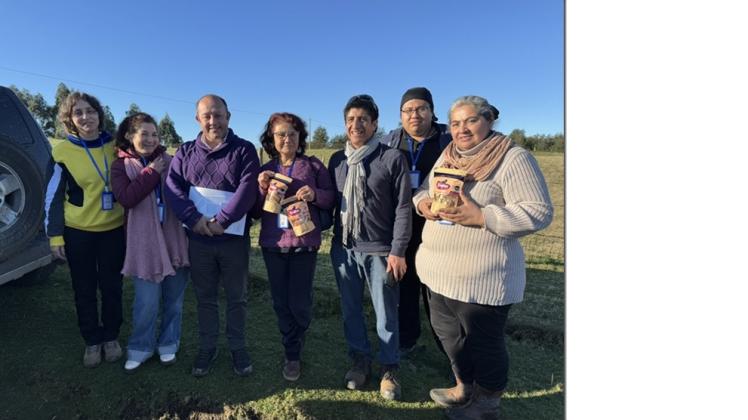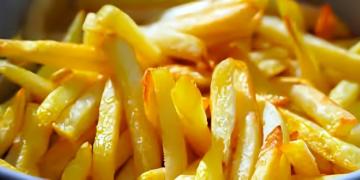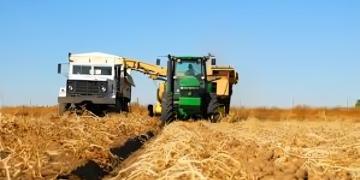Chile: Potato producers from La Araucanía participate in a technical tour to Chiloé
The tour - awarded by INIA Carillanca and supported by FIA - aimed to teach 14 farmers about native varieties and agroecological management.

Potato cultivation in La Araucanía occupies a significant area within the regional agricultural sector, with a high social impact, as approximately 75% of its production is in the hands of small farmers, who specialize in traditional red-skinned potato varieties. Furthermore, in Chile, demand for organic, healthy, and gourmet products, including native potatoes, has increased. This represents a productive niche with high potential in the region due to its optimal soil and climate conditions.
However, farmers are not always familiar with native varieties and agroecological management methods that allow them to fully exploit this potential. Faced with this opportunity, INIA Carillanca was awarded a technology tour to Chiloé Island, supported by the FIA (Foundation for Agrarian Innovation) agency, given that this area is considered the birthplace of the potato and has a vast history of production and marketing.
The activity, led by INIA researcher Dr. Mayeli Moreno, included farmers from Carahue, Saavedra, Teodoro Schmidt, Toltén, Freire, and Gorbea; PDTI and PRODESAL technicians; and professionals from INDAP and INIA. This fostered the exchange of knowledge in agroecology, harvesting, storage, processing, associative practices, and marketing of native potatoes for fresh consumption and processed products. “The overall objective of this initiative was to strengthen the productive and commercial capacities of participating farmers and technical teams, diversifying their systems and improving their competitiveness in diverse markets. As a result of the tour, we will publish an informative report on the lessons learned and the identified productive potential, in addition to holding a seminar to share experiences with other farmers and professionals, in order to evaluate the feasibility of implementing the technologies on farms in La Araucanía,” stated Dr. Moreno.
In this regard, Marcos Rebolledo, FIA representative in La Araucanía, stated, "This is a tour of utmost importance for the coastal region of our area. Learning about the experience of Chiloé producers will open up new productive possibilities for potatoes, encompassing new business opportunities and positioning them in the national and regional markets. For our Foundation, it is essential to support these types of initiatives because they provide a valuable exchange of knowledge and practices already established in other regions. Learning is essential for sustainable innovation."
Problem to solve
In La Araucanía, potato cultivation is a highly significant agricultural activity, with 8,833 hectares under cultivation and a production of more than 253,000 tons, positioning the region as the national leader in acreage devoted to this crop. This production is primarily in the hands of small farmers located in communities such as Carahue, Saavedra, Toltén, Teodoro Schmidt, Freire, and Gorbea. However, despite the area’s favorable agroclimatic potential, the production system is poorly diversified, concentrating on traditional varieties such as Patagonia INIA, Asterix, and Desirée.
This lack of diversification limits producers’ ability to access more demanding markets with greater added value, in a context where consumers demand differentiated products, such as native potatoes. Although these varieties are present on some farms, they have not been incorporated into the commercial production system. This is due to the widespread lack of knowledge among farmers, technicians, and professionals regarding their agronomic management, harvesting, storage, and marketing.
In this sense, there is an opportunity in incorporating native potatoes from Chiloé, which stand out for their shape, color, flavor, and high antioxidant content. These varieties respond to the growing demand for healthy, gourmet, and organic products, offering a path to improving farmers’ incomes and competitiveness. To take advantage of this opportunity, a technical tour was held, allowing beneficiaries to learn about successful experiences in Chiloé, acquire practical knowledge, and adapt it to their own production situations.
The most affected by this problem are small farmers in the aforementioned communities, who face limitations in both knowledge and access to new markets. Technicians and professionals from institutions such as the National Institute of Agricultural Research (INIA) and local municipalities are also involved, playing a key role in providing technical advice.
During the tour, three key solutions were identified: (i) specific agroecological practices for native potatoes, (ii) harvesting and storage techniques that reduce losses, and (iii) marketing strategies geared toward differentiated markets, based on collaborative work. Unlike the conventional model present in Araucanía—focused on traditional varieties, self-consumption, and individual production—the experiences in Chiloé demonstrate a more consolidated production system with added value, an associative approach, and access to local and national markets.
The knowledge acquired on this tour will allow participants to diversify their production, improve the quality of their products, and strengthen their innovation capacity. With technical support, they will be able to implement adapted agroecological practices, improve their harvesting and post-harvest processes, and advance the creation of cooperatives or other forms of association that will allow them to improve their marketing and increase their income.
Finally, it should be noted that this initiative aligns with FIA’s strategic challenge "Sustainable Food Systems," as it addresses issues of primary production, post-harvest improvement, and strengthening value-added marketing channels. Therefore, the tour contributes to building more sustainable, resilient, and inclusive food systems in La Araucanía.
Fuente: Traducido por Argenpapa de: araucanianoticias.cl




